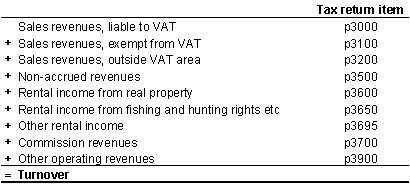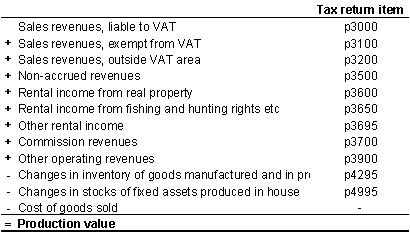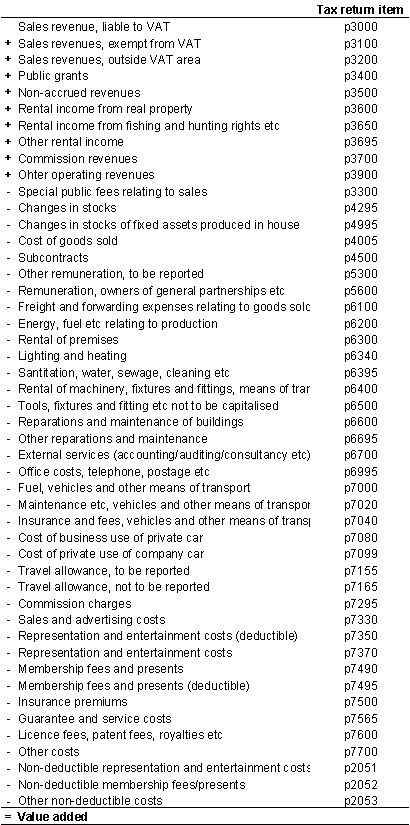Content
About the statistics
Definitions
-
Name and topic
-
Name: Wholesale and retail trade, structural statistics
Topic: Wholesale and retail trade and service activities
-
Responsible division
-
Division for Structural Business Statistics
-
Definitions of the main concepts and variables
-
Enterprise
In the Standard Industrial Classification (SIC) an enterprise is the smallest combination of legal entities that is an organizational unit producing goods or services, which benefits from a certain degree of autonomy in decision making.Local kind-of-activity unit (local KAU)
SIC defines a local KAU as a functional unit, which at a single physical location is engaged primarily in activities within a specific activity group.Location
Location is according to municipal borders at 1 January in the reference year. In some industry divisions an enterprise can do business in several municipalities and counties without being divided into several KAUs. In such cases the enterprise's combined operations are registered where the enterprise has its office address.Owners without regular pay who work for the enterprise on a daily basis
Owners include owners of sole proprietorships, or general partnerships, and family members who work for the enterprise on a daily basis without receiving regular wages. Co-owners of limited companies and cooperatives who are paid for working for the enterprise are not included, nor are family members of owners of sole proprietorships or general partnerships when they receive regular wages.Employees
An employee is a person that works for an employer and receive compensation in the form of wages, pay, fee, bonuses, payment in kind etc. The number of employees in the structural statistics shows an average of the number that has been employed throughout the year.Temporary staff from employment agencies are not included in the employment figures.
Employment
The employment is the sum of owners and employees working in the unit.Part-time employees
Employees are defined as part-time if they work less than 30 hours per week.Man-years
The figures include the number of man-years worked by the employees in an enterprise.Turnover/sales
Turnover is defined as the sum of remuneration for rendering of services to customers and sales of merchandise, and gross income from other activities. Rental income, commissions and special taxes are included, while subsidies and profits from sales of business assets are not. VAT is not included in the statistics.
Merchandise
Merchandise is goods bought and resold with no added value.Compensation of employees
Compensation of employees includes wages, holiday pay, fees, etc., employer's national insurance contribution, reportable pension costs and other personnel costs. Compensation of employees does not include remuneration to owners of sole proprietorships or partnerships or to family members without regular wages.Production value
Production value means sales corrected for changes in stocks of finished goods, work in progress, and goods and services purchased for resale. Purchases of goods and services for resale are deducted, while capitalized own investment work is added.
Value added
Value added is figured as the sum of production value less the purchase of goods and services (for other goods and services than those purchased for resale) and special public taxes, and corrected for changes in stocks of raw materials and consumer goods. Special public subsidies for manufactured/sold merchandise and other public subsidies/reimbursements are included.
Gross investments
Gross investments are the total value of new capital goods such as buildings and plant, machinery, tools, implements, software, vehicles (except for personal use), both new and used. Improvements are added while sales of used capital stock are deducted. Investment figures are minus incoming value added tax.Acquisitions
This includes investments in new assets and improvements of own assets.New investments include all newly acquired fixed assets acquired and completed in the course of the year, excluding investments in unimproved property. In assessing the value of the business asset, cost price is used for purchases and production cost for own manufactures. Acquisitions through financial leasing are included when the asset is entered as an asset in the balance sheet.
Improvement of own assets includes the value of all capitalized improvements and major repairs purchased and executed by others and/or undertaken by own employees on own business assets. A precondition is that such improvements increase the efficiency/value of and/or prolong the lifetime of the business asset. The improvement is estimated at purchase price at time of purchase or at production cost when it is manufactured.
Sale of business assets
Sale of business assets is estimated at the sales value (replacement value) upon realization of used business assets over the course of the year. The amount includes investment tax. The business asset is regarded as sold when it is delivered.
-
Standard classifications
-
The Standard Industrial Classification used in Statistics Norway (SN2007) is based on the EU standard NACE Rev. 2 and the UN standard ISIC Rev. 4.
Administrative information
-
Regional level
-
National level. Region and county level for some of the main variables. Other variables at the county and municipal level may be ordered.
-
Frequency and timeliness
-
Annual. Preliminary figures are presented 10 months after the end of the reference period, final figures within 18 months after the end of the reference period.
-
International reporting
-
The statistics are reported to EUROSTAT.
-
Microdata
-
Primary data and the compiled statistics are stored temporarily in the programming language SAS, and stored permanently as text-files.
Background
-
Background and purpose
-
The statistics offer a detailed overview on activity and structur in industry section G, Wholesale and Retail Trade, based on accounting figures.
The statistics were first published in 1956, and have been published in the present form since 1995. Starting with reference year 2001, preliminary figures for the variables number of enterprises, turnover and employment has been published.
-
Users and applications
-
The annual structural statistics are based on the data needs of the annual national accounts and in accordance with the EU regulation on structural business statistics. In addition, ministries and various trade organizations want and need statistical data, and the public's need for information has to be met too. Industry and other users also commission customized wholesale and retail trade statistics from Statistics Norway, primarily at the municipal level.
-
Equal treatment of users
-
No external users have access to the statistics and analyses before they are published and accessible simultaneously for all users on ssb.no at 8 am. Prior to this, a minimum of three months' advance notice is given in the Statistics Release Calendar.
-
Coherence with other statistics
-
The structural statistics on wholesale and retail trade are a part of Statistics Norway industrial statistics, covering most industries. Short-term statistics are published for certain industries in addition to the structural statistics. These show figures for shorter periods than one year and usually for the entire country as a whole.
There may be some deviation between the structural statistics and the wholesale and retail trade sales statistics. This is because some of the enterprises in the structural statistics use an deviating accounting year, while the wholesale and retail trade sales statistics follows the calendar year.
Accounting statistics are also compiled for the wholesale and retail trade. There are some systematic differences between the structural statistics and accounting statistics. The accounting statistics include only limited companies, while the structural statistics also include other organizational types. As a consequence, the amounts in the structural statistics will normally be higher than in the accounting statistics. The accounting statistics are only compiled at enterprise level, while the structural statistics are also compiled at the local KAU level. The results of regionalization derived from enterprises will differ from the results of regionalization derived from local KAU units. Comparisons between the structural statistics and the accounting statistics should therefor be made with reservation.
The structural statistics are used as a basis when compiling the national accounts.
The employment figures in the structural business statistics are not directly comparable with other employment statistics, such as the register-based employment statistics. The register-based employment statistics are based on people who are employed, while structural statistics say something about the companies and enterprises in the population. Users should be aware that definitions and methodology differs somewhat between the various statistics and therefore differences in the figures may occur. Definition of employees and number of persons employed can be found in the definitions section.
-
Legal authority
-
The Statistics Act, Sections 2-2, 2-3 and 3-2
-
EEA reference
-
EU Council regulation No 58/97 December 20, 1996.
Production
-
Population
-
The structural statistics for industry G Wholesale and retail trade are organized according to the standard industrial classification (SIC2007) and include the industry divisions:
45 Wholesale and retail trade and repair of motor vehicles and motorcycles
46 Wholesale trade, except of motor vehicles and motorcycles
47 Retail trade, except of motor vehicles and motorcycles
The structural business statistics comprise most of the enterprises that are registered in the abovementioned industry division, as long as the enterprise was registered with activity in Norway in the relevant statistical year.
The exception is enterprises within the public service sectors 6100 and 6500. Such units are not included in the structural business statistics for wholesale and retail trade even though they should happen to have operations in the abovementioned industry.
However, all other enterprises in the public sector or owned by the public sector, i.e. units with sector codes 1110, 1120, 1510 og 1520, are included in the statistics if they have activity in the abovementioned industry.
Preliminary figures are published at the enterprise level for 3-digit industry level, while the final figures are published both on the local KAU and enterprise level for several industry levels.
The EU's structural regulation primarily requires statistics at the enterprise level. Out of consideration to the national accounts and other norwegian users, statistics are also compiled at the local KAU level, for the variables employment, turnover, compensation of employees and investments.
-
Data sources and sampling
-
The population consists of all enterprises in the relevant industry divisions with registered activity in the reference year. The population is divided into subpopulations, called strata, after criteria like industrial classification and number of employees. On the basis of these strata, a representative sample of enterprises is drawn, and these are asked to submit a complete set of information: Income statement and a supplementary form. Draw probability varies between the different strata, but all enterprises with more than one local kind-of-activity unit (local KAU) are drawn regardless.
Information, like the accounts and turnover, about the enterprises with only one local KAU outside the sample is obtained from the following sources:
- income statements electronically submitted to the Norwegian Tax Administration
- the Register of Annual Company Accounts in The Brønnøysund Registers
- the VAT Register
From the statistical year 2015 the number of employees is collected via A-ordningen, where employers are obligated to submit monthly reports for everyone who receives wages and salaries. Previously, these figures were collected through the register of Employers and Employees. These two sources are not directly comparable.
Information about investments are collected from the Write-off form RF 1048B from the Norwegian Tax Administration.
The Register of Establishments and Enterprises at Statistics Norway is used to obtain necessary information about the population. The VAT Register, the Register of Business Enterprises, information from trade organizations and direct input from the enterprises are used to update the Register of Establishments and Enterprises.
-
Collection of data, editing and estimations
-
A complete set of statements (income statements with supplementary forms) is obtained from a sample of enterprises.
The supplementary forms are mainly collected electronically via the internet. Enterprises that do not respond are imposed a coercive fine.
Income statements and information from the Write-off form from the Tax Administration, turnover figures from enterprises in the VAT Register, annual company accounts from The Brønnøysund Registers and employment figures from the employer/employee register are all collected electronically.
Thorough checks and corrections of supplementary forms and income statements of the companies included in the sample are made. Particularly critical control items are industry code, employment, turnover, compensation of employees, other operating expenses and operating profit. In addition, figures for goods for resale (in the same condition as received) and investments are also checked and edited. If necessary, further inquiries are made by contacting the respondent.
Data for the entire population are checked against figures from the previous year, and by looking at ratios between different variables. The end result are assessed against short-term statistics like the index of retail sales and the wholesale and retail trade sales statistics.
The data are not as thoroughly edited when the preliminary figures are published as they are when the final figures are published.
For the enterprises in the sample, where a complete income statement and supplementary form exists, no variables are estimated. For enterprises not in the sample, but where income statements are obtained, only variables from the supplementary form are estimated. For the remaining enterprises, all variables except turnover and employment are estimated on the basis of figures from the sample. For units which do not report employment to the register, but have salary figures or sales figures that indicate employment, the employment rate is calculated.
Turnover and employment are considered as known variables for all enterprises and are therefore used as a basis for computing missing variables. Previously an industry mean based on sample units was used to estimate missing data for non-sample units (ratio estimates). As of the statistical year 2011 the method is based on finding a sample unit similar to the non-sample unit to be estimated, based on a set of criteria, and using the sample-unit to estimate the missing values (nearest neighbour estimation). The nearest neighbour criterion is industry combined with the turnover/employment ratio, in that order.
-
Seasonal adjustment
-
Not relevant
-
Confidentiality
-
If less than three units represents a statistical variable or one or two units dominate, no economic variables are published. The reason is the risk that the units can be identified.
-
Comparability over time and space
-
Up until the reference year 2001, the Standard Industrial Classification 1994 (SIC94) was used. From the reference year 2002 until the reference year 2007 the Standard Industrial Classification 2002 (SIC2002) was used. This means that not all industries are comparable backwards on 4 - and 5 - digit level . This is indicated by a break in the tables that are affected. The change of classification had no influence on 2- digit level. Nor were there any changes on the 3-digit level, except that two industries got a different code.
Starting with reference year 2008, The Standard Industrial Classification 2007 (SIC2007) has been used. The main change in wholesale and retail trade is that petrol stations have become part of the retail sector. In addition, some industries have been split to give better industry statistics. As an example, sporting goods stores and kiosks have been split into own subclasses.
Previously, investments were collected from the sample, as part of the supplementary form, and then estimated for the rest of the population. Starting with the year 2008, figures for gross investments are collected from the Write-off blankett RF 1048B from the Tax Administration. This source provides more accurate figures for investments.
From the statistical year 2015 the number of employees is collected via A-ordningen, Previously, these figures were collected through the register of Employers and Employees. These two sources are not directly comparable.
Preliminary figures are published while data are still under revision, and may therefore deviate from the final figures that are published within 18 months of the end of the reference year. Preliminary data for the enterprises in the sample that has not yet responded at the time of publishing are estimated by using other sources.
Accuracy and reliability
-
Sources of error and uncertainty
-
The results of a statistical survey will as a rule contain some measurement, processing and sampling errors.
Measurement errors occur when the provider of the data gives erroneous answers due to forgetfulness, misunderstanding of the question etc.
Processing errors are errors from coding or errors that occur during the transferring of information from the questionnaire to the machine-readable medium or during editing.
Non-response will always be a factor in form-based surveys. This is because some respondents either do not return their forms or return them incompletely filled out. The enterprises that do no not return their forms are treated like the enterprises outside the sample.
Sampling errors is the uncertainty that occurs when the figures are produced on the basis of a sample of data, and not the whole population. The sampling error is the expected deviation between the result of the sample and the result if the whole population were examined.
Imbalances in the sample (e.g. misleading stratification) can cause errors for the variables for which information has not been obtained for all units in the population. Statistics Norway assumes explicitly by the imputation that enterprises outside the sample have the same cost and income structure as enterprises in the sample.
In the structural business statistics The Register of Establishments and Enterprises at Statistics Norway, the Register of Business Enterprises, the Register of Annual Company Accounts in The Brønnøysund Registers, the VAT Register and the employer/employee register (the AA Register) are all used in order to define the population and help collect the necessary data.
Errors in these administrative registers - like time gaps in registration, incorrectly identified unit characteristics etc. may therefore be a potential source of uncertainty in the statistics and may for instance have an impact when dividing the population into adequate strata.
-
Revision
-
Not relevant
The statistics is now published as Business statistics.
Additional information
The statistics have figures for both local KAUs and enterprises, but preliminary figures are published only on enterprise level.
The figures for enterprises will deviate from the figures for local KAUs. The reason is that enterprises that are registered with principal activity in one industry may have local KAUs with activities in other industries.
Read more in About the statistics .
